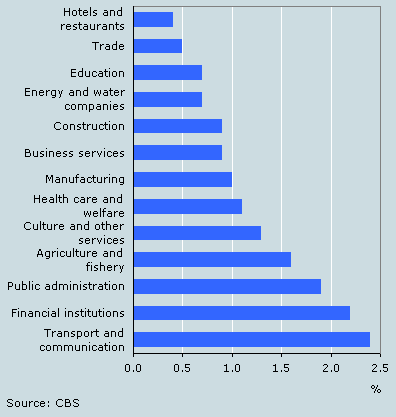Collectively agreed wages up 2 percent in 2006

Wages agreed in collective negotiations between trade unions and employers rose by 2.0 percent in 2006. This is a much larger increase than the 0.7 percent rise in 2005.
Wage increase larger than inflation in 2006
Once inflation, 1.1 percent in 2006 , has been discounted, the increase in collectively negotiated wages is 0.9 percent. In 2005 the wage increase was significantly smaller than inflation. The difference between inflation and the collectively negotiated wage increase has not been this large since 1999.
However, this has not necessarily resulted in an increase in purchasing power for employees. The net wage also depends on changes in employee-paid premiums for pension, social insurance (including health insurance) and wage tax. In 2006 these effects differed strongly between various employees as a result of the introduction of the new health insurance scheme.
Increase in special allowances
Part of the increase in the collectively agreed wages is accounted for by the increase in special allowances. If these special allowances are not taken into account, the wage rise is 1.6 percent. The 0.4 percent increase in special allowances is a result of the contribution of employers to the life course savings scheme and health insurance costs.
Collectively agreed wages

Wage costs rise more slowly than wages
Just as in 2005, the contractual wage costs rose by 1.2 percent. This is first time since 2002 that they rose by less than the collectively agreed wages. The main reason for the smaller increase was the lower employer-paid premiums for disability insurance and pensions. In 2005 the increase in wage costs was still 0.5 percent higher than the increase in the wages.
Increase in collectively agreed wages and contractual wage costs

Largest wage rise in transport and communication
With a wage rise of 2.4 percent, the transport and communication sector had the largest increase in collectively agreed wages. The contractual wage costs in this sector rose by 0.2 percent more than the collectively agreed wages. This was mainly the result of higher employer-paid pension premiums.
The smallest wage rises were reported for the sectors energy and water supply, education, trade, and hotels and restaurants. Wage costs rose by least in the hotels and restaurants sector: 0.4 percent. In 2004 and 2005, too, the increase in wages costs was smallest in this sector.
Increase in contractual wage costs by sector of industry, 2006

Nathalie Peltzer